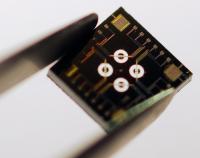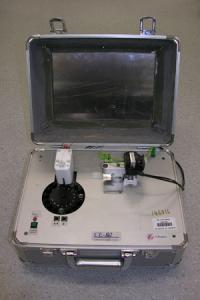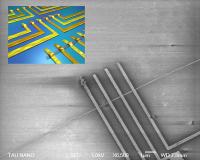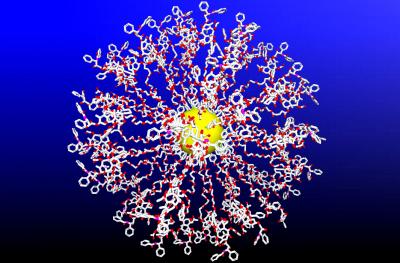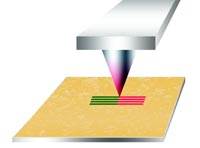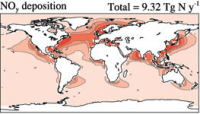Chemistry News Archive September 2007 |
|
News of the year 2007 in the fields of chemistry and chemistry-related topics like biochemistry, nantechnology, medicinal chemistry etc. Main focus: press releases, scientific research results and summaries of chemistry articles, that are published in chemistry journals. Please send us a eMail to publish your press release! |
|
|
Chemistry news archive 2007 - ordered by month |
|
|
|
- |
Spin
Polarisation with Long-Term Memory |
|
|
- |
Researchers
detect hint of oxygen 50 to 100 million years earlier than first
believed |
|
|
- |
Interacting protein
theory awaits test from new neutron analysis tools |
|
|
- |
New
field-deployable biosensor detects avian influenza virus in minutes
instead of days |
|
|
- |
BAM puts a new
search tool for dangerous goods packagings on the web |
|
|
- |
Sodium loses its luster: A liquid metal that's not really metallic |
|
|
- |
Engineered eggshells to help make hydrogen fuel |
|
|
- |
Plants can be used to study how and why people respond differently to
drugs |
|
|
- |
Model for the assembly of advanced, single-molecule-based electronic components developed at Pitt - Template for creating 1-molecule wide wires for crafting molecular level organic semiconductors published in the Journal of the American Chemical Society. |
|
|
- |
Using
catalysts to stamp nanopatterns without ink |
|
|
- |
Scientists
get first look at nanotubes inside living animals |
|
|
- |
Fishing for a better bit of batter Good news for lovers of fish and chips, Japanese scientists have come up with the perfect recipe to make a crispy batter which is also lower in fat, reports Joanna Harries in Chemistry & Industry, the magazine of the SCI. Dr Thanatuksorn and his team at Tokyo University of Technology studied how the structure of the batter molecules changes during the frying process. By altering the water content and frying time they were able to suggest the perfect conditions to create batter with the best lasting crispiness, as well as helping to reduce the fat content. During the deep-frying process a rigid microstructure of pores is formed in the batter, and this microstructure is responsible for the textural properties of the food, as well as determining how much oil is absorbed during the frying. The amount of water in the batter before and after frying is critical. Water evaporates during cooking creating the pores responsible for crispiness, but residual moisture remaining after causes the batter to go soggy. According to Thanatuksorn�s research, larger pores trap less oil during cooking so will reduce the amount of fat in the cooked food. By using a batter with a moisture content of 60% and frying for 5 minutes a highly crisp lower-fat batter is formed. The scientists say the residual moisture should be less than 5%. Thanatuksorn says this method can be extended to other food types, so next on the menu could be perfect chips. Journal of the Science of Food and Agriculture (Wiley, doi 10.1002/jsfa.3027): "Characterization of deep-fat frying in a wheat flour-water mixture model using a state diagram" |
|
|
|
|
|
|
|
ACS News: |
|
|
- |
Spinning a new role for CDs and CD players CD-ROMs and DVDs and the hardware used to play these popular audio and video compact discs (CDs) have �enormous� potential as a new generation of portable, inexpensive instruments for home health monitoring and laboratory-based testing, scientists in Spain are reporting in the Oct. 15 issue of ACS� Analytical Chemistry, a semi-monthly journal. CD technology could be adapted for tests ranging from the measurement of environmental toxins to at-home disease diagnosis, their report said. In the study, Angel Maquieira and colleagues demonstrated technology that uses ordinary CDs and CD players as analytical tools with the potential for performing a range of key laboratory tests. As proof of principle, they developed a CD with a surface coating of so-called immunoassay materials and used it to identify three pesticides - 2,4,5-TP, chlorpyriphos, and metolachlor � placed on the disc. Upon spinning in a CD player with its standard laser light, the compounds caused changes in light intensity. A computer interpreted those changes and correctly named the compounds. �The obtained results show the enormous prospective of compact discs in combination with CD players for multiresidue and drug discovery applications,� the article states. The researchers are currently working on ways to increase the sensitivity and versatility of the new technique. Analytical Chemistry: �Microimmunoanalysis
on Standard Compact Discs To Determine Low Abundant Compounds� [PDF]
|
|
|
- |
Toward pure white light: Next-generation LEDs show bright promise Scientists in India are reporting an advance toward discovering a Holy Grail of the illumination industry - a white LED, a light-emitting diode that produces pure white light suitable for interior lighting of homes, offices and other buildings. Their study is in the Sept. 9 issue of ACS� The Journal of Physical Chemistry C, a weekly publication. In the report, D. D. Sarma and Angshuman Nag point out that practical versions of these so-called white LEDs would be brighter, longer-lasting and more energy efficient than conventional light sources such as incandescent and fluorescent lamps and could replace them in the future. However, scientists have faced several difficulties in developing pure white LEDs with all the requirements and desirable properties. Existing versions produce tinted, unstable shades of white light that mar their performance. The researchers report the first success in developing a new LED based on a new phosphor from semiconductor nanocrystals of cadmium sulfide mixed with manganese. It produces a stable shade of white light that remains constant over time and appears superior in overall performance in comparison to previous generations of white LEDs. The scientists now are working to boost its efficiency so that the white LED can be used in everyday applications. The Journal of Physical Chemistry (C): �White
Light from Mn2+-Doped CdS Nanocrystals: A New Approach" [PDF] |
|
|
- |
Juice from the pomegranate shows promise for fighting prostate cancer. Photo � by USDA Agricultural Research Service Journal of Agricultural and Food Chemistry: �Pomegranate Ellagitannin-Derived Metabolites Inhibit Prostate Cancer Growth and Localize to the Mouse Prostate Gland� [PDF] |
Pomegranate juice: Tart, trendy, and targeted on prostate cancer cells Journal of Agricultural and Food Chemistry Researchers in California are reporting new evidence explaining pomegranate juice�s mysterious beneficial effects in fighting prostate cancer. In a study scheduled for the Sept. 19 issue of ACS� Journal of Agricultural and Food Chemistry, a bi-weekly publication, Navindra Seeram and colleagues have found that the tart, trendy beverage also uses a search-and-destroy strategy to target prostate cancer cells. In previous research, Seeram�s group found that pomegranate juice consumption had a beneficial effect for prostate cancer patients with rising prostate-specific antigen (PSA) levels. Such increases in PSA signal that the cancer is progressing, �doubling time� a key indicator of prognosis. Men whose PSA levels double in a short period are more likely to die from their cancer. Pomegranate juice increased doubling times by almost fourfold. In the new study, they researchers discovered evidence in laboratory experiments that pomegranate works in a �seek and destroy� fashion. On consumption, ellagitannins (ET), antioxidants abundant in pomegranate juice, break down to metabolites known as urolithins. The researchers showed that the urolithins concentrate at high levels in prostate tissue after being given orally and by injection to mice with prostate cancer. They also showed that urolithins inhibited the growth of human prostate cancer cells in cell culture. �The chemopreventive potential of pomegranate
ellagitannins and localization of their bioactive metabolites in mouse
prostate tissue suggest that pomegranate may play a role in prostate
cancer treatment and chemoprevention,� the researchers state,
recommending further clinical studies with pomegranate and prostate
cancer patients. |
|
- |
Printing with enzymes instead of ink With all the advances in printing technology in recent years, the latest may rise to the top of a list that would make Gutenberg gasp. Scientists in North Carolina are reporting development and testing of a method for printing finely-detailed microscopic images with an enzyme, rather than ink. In the study, Eric J. Toone and Robert L. Clark and colleagues point out that so-called microcontact printing has found wide application for rapidly transferring high-resolution images onto large surfaces. But current nanoprinting technology relies on the diffusion of ink, and cannot reproduce details smaller than one hundred nanometers in diameter - about 400 times smaller than the width of a human hair. The new technology, termed biocatalytic microcontact printing, involves coating a nano-�stamp� with an enzyme - a protein that speeds up chemical reactions. The enzyme then digests away a layer on the surface, leaving behind an imprint almost like an old-fashioned rubber stamp. Because no diffusion of ink is involved in the process, the resolution of microcontact printed images is about one hundredfold greater than possible with conventional technology. The technique may point the way toward faster, less expensive methods of nanolithography, which could be used to create complex structures for micromachines, biosensors, and other nanoscale devices, the researchers suggest. Journal of Organic Chemistry: �Biocatalytic
Microcontact Printing� [PDF] |
|
|
- |
Drug-resistant tuberculosis rises, but new treatments in the pipeline An arsenal of promising new medications, vaccines, and diagnostic tests are moving toward the global battlefield that pits medicine against drug-resistant tuberculosis (TB), which is claiming a terrible toll, particularly in HIV-infected individuals, according to an article of Chemical & Engineering News, ACS� weekly newsmagazine. In the cover feature, C&EN senior correspondent Ann Thayer and assistant editor Carmen Drahl describe far-ranging efforts underway to develop new TB diagnostic tests and treatments. For years, conventional treatments for TB had slowed the spread of the disease, but the emergence of new drug-resistant strains has reduced the effectiveness of those medications. Researchers are developing more accurate diagnostic tests, new drugs to fight multidrug resistant strains, and ones that are more compatible with individuals who are undergoing treatment for HIV. Scientists are also developing more effective vaccines, including those that might show promise for both preventing and treating the disease, Thayer notes. �In the past five years or so, the TB drug pipeline has shifted from nearly empty to having about 30 compounds under investigation; several are in early clinical testing,� Thayer writes. Chemical & Engineering News: �Taking Down TB�.Taking Down TB |
|
|
|
|
|
|
- |
How much is a
kilogram? |
|
|
- |
Scientists
decipher mechanism behind antimicrobial 'hole punchers' |
|
|
- |
Argon conclusion
|
|
|
- |
CO2
emissions could violate EPA ocean-quality standards within decades
|
|
|
- |
Researchers
Genetically Engineer Microorganisms into Tiny Factories |
|
|
- |
Severe heart attack damage limited by hydrogen sulfide |
|
|
- |
Advance by chemists may lead to better displays on laptop computers,
cell phones |
|
|
- |
Research
overturns accepted notion of neutron's electrical properties
|
|
|
- |
New microsensor measures volatile organic compounds in water and air on-site Researchers at the Georgia Institute of Technology have developed a miniature sensor that uses polymer membranes deposited on a tiny silicon disk to measure pollutants present in aqueous or gaseous environments. An array of these sensors with different surface coatings could be used during field-testing to rapidly detect many different chemicals. |
|
|
- |
Sweet Smell of
The Good Earth |
|
|
- |
If you
think cancer genes are simple, you don't know JAK |
|
|
- |
Mechanism for
the in-vivo transport of siRNA |
|
|
- |
Scientists reveal
DNA-enzyme interaction with first ever real time footage |
|
|
|
|
|
|
|
ACS News: |
|
|
- |
This "briefcase" is actually an anti-terror device for detecting homemade bombs. Image: Courtesy of Joseph P. Hutchinson, University of Tasmania, Australia |
New technology for tracking down builders of homemade bombs Researchers in Australia are reporting development of a portable device to help track down builders of improvised explosive devices (IEDs) - those homemade fertilizer bombs that have wreaked such havoc in terrorist attacks around the world. Their study appeared in the Sept. 15 issue of ACS� Analytical Chemistry, a semi-monthly journal. Paul R. Haddad and colleagues point out that IEDs have become a mainstay weapon for terrorists, resulting in an urgent need for new technology to identify and eliminate the sources of the explosives. However, quickly and reliably identifying the chemicals used in these crude but deadly bombs remains a major challenge to investigators. IEDs are often made with a diverse array of conventional, easy-to-obtain materials that require slow and painstaking analysis in the laboratory following an explosion. The new technology streamlines that process, quickly and accurately identifying the chemical composition of blast residues from IEDs in the field. It consists of an instrument, about the size of a briefcase, based on a modified form of capillary electrophoresis, a mainstay technology for separating components in a mixture. In the study, researchers used it to identify major components of blast residues in less than 10 minutes. Analytical Chemistry: �Identification
of Inorganic Improvised Explosive Devices by Analysis of Postblast
Residues Using Portable Capillary Electrophoresis Instrumentation and
Indirect Photometric Detection with a Light-Emitting Diode� [PDF] |
|
- |
New way to watch the lipid flip - flippases, flopases, and scramblases The �lipid flip� may sound like a rock and roll dance craze from the 1960s. However, it actually is a key biochemical process in which fatty materials termed lipids move into cells - movements that are pointing toward improvements in gene therapy, new medications for preventing the complications of Alzheimer�s disease, and other health boons. In an article in the Sept. 19 (2007) issue of ACS� Bioconjugate Chemistry, a bi-monthly journal, Vladimir Sidorov and colleagues report development of a new non-invasive method for monitoring the activity of lipid-flipping enzymes. Colorfully named flippases, flopases, and scramblases, these enzymes control the process in which lipid molecules literally summersault from the outer layer of a cell membrane to the inner layer where they can move into the cell itself. The actions of those enzymes can influence blood clotting, whether a cell lives or programs itself for death, and other processes. In their study, the researchers describe drawbacks in existing methods for monitoring lipid. Their new laboratory method overcomes those problems, and permits monitoring of the lipid flip in actual cell membranes in real time, as the process unfolds. Bioconjugate Chemistry:�New
Noninvasive Methodology for Real-Time Monitoring of Lipid Flip� [PDF]
|
|
|
- |
Photo and illustration (inset) of carbon nanotube circuits. Image: Courtesy of Ze�ev Abrams and Yael Hanein, Tel-Aviv University, Israel
|
Toward next-generation integrated circuits made from carbon nanotubes Scientists in Israel are reporting the first simple and inexpensive method for building the large-scale networks of single-walled carbon nanotubes (SWCNT) needed for using these microscopic wisps in a future generation of faster, smaller, and more powerful computers and portable electronic devices. In a study in the Sept. 12 (2007) issue of ACS� Nano Letters, a monthly journal, Yael Hanein and colleagues point out that no assembly method has solved all of the key problems involved in fabrication of large networks. Those problems range from aligning SWCNTs in a preset pattern to integrating carbon nanotube circuits into an integrated circuit environment similar to those at the heart of conventional microprocessors. The study describes a method to manufacture and assemble large arrays of SWCNTs into an integrated circuit format. It can be used on a variety of surfaces and produced on an industrial scale. The process involves creating networks of nanotubes suspended between silicon pillars, which are then transferred onto other surfaces by direct stamping, the researchers say. Nano Letters: "A
Complete Scheme for Creating Predefined Networks of Individual Carbon
Nanotubes" [PDF] |
|
- |
Fast, portable test promises to help detect flammable liquids in arson Researchers in Ohio are reporting development of an inexpensive portable test for accurately identifying flammable liquids used in arson - the leading cause of fires and the second leading cause of fire deaths in the United States. Identification of flammable liquids used in arson usually requires time-consuming laboratory tests, Yao Lu and Peter Harrington point out. The new test, called gas chromatography-differential mobility spectrometry (GC-DMS), works fast and is small enough for use in the field, they say. In laboratory studies, the researchers added seven different flammable liquids to carpet samples and then ignited the samples to simulate an arson event. Analysis of the burned carpet with GC-DMS identified the individual flammable liquids with an accuracy rate of 99 percent. The results demonstrate that this novel test �could be successfully used for forensic analysis of ignitable liquids from fire debris,� the report states. Analytical Chemistry: �Forensic
Application of Gas Chromatography-Differential Mobility Spectrometry
with Two-Way Classification of Ignitable Liquids from Fire Debris�
[PDF]
|
|
|
- |
Preventing future bridge collapses: Protective coatings may hold key In the wake of the tragic bridge collapse in Minnesota and last year�s shut down of an oil pipeline in Alaska due to corrosion, researchers are facing increased pressure to develop better protective coatings to help save aging infrastructures, according to an of Chemical & Engineering News, ACS� weekly newsmagazine. Protective coatings and paints, such as epoxy resins and polyurethanes, are designed primarily for warding off corrosion in metal-based structures such as bridges, storage tanks and buildings. Part of a fast-growing, multibillion dollar industry, these chemicals have played an important but unsung role in protecting structures for many years, writes C&EN Senior Editor Alexander H. Tullo. In the article, Tullo highlights efforts by coating manufacturers to balance long-term coating protection with growing customer demand for ease of use and lower prices and societal demands for reducing volatile organic emissions from paints and other coatings. He describes new multi-functional coatings that reduce the number of protective coats applied while retaining maximum coating performance and faster-acting curing agents that get paint jobs finished more quickly. But disasters aren�t the only thing fueling demand for better coatings. A boom in construction work in emerging economies in China, India, and Eastern Europe is also increasing demand, Tullo notes. Chemical & Engineering News: �Paints and Coatings� |
|
|
|
|
|
|
- |
Revealing
the workings of 'Mother Nature's blowtorch' |
|
|
- |
Sheet of
carbon atoms acts like a billiard table, physicists find |
|
|
- |
NIST team
develops novel method for nanostructured polymer thin films
|
|
|
- |
Probing a rare
material spin state at NIST |
|
|
- |
Boston College profs study oxidative stress subcellular to discover
its role in diseases |
|
|
- |
Compounds
Inhibit Tumor Cell Growth - Drug Targets are Components of the Wnt
Pathway |
|
|
- |
Nuclear
physicists examine oxygen's limits |
|
|
- |
Using green
chemistry to deliver cutting-edge drugs |
|
|
- |
New
Mechanism Discovered for DNA Recombination and Repair |
|
|
|
|
|
|
- |
Taxol bristle ball: a wrench in the works for cancer Dozens of cancer-clogging drug molecules loaded onto tiny gold sphere. Open access article: Gibson, J. D.; Khanal, B. P.; Zubarev, E. R. - Paclitaxel-Functionalized Gold Nanoparticles - publisahed in J. Am. Chem. Soc.; (Article); 2007; 129(37); 11653-11661; doi: 10.1021/ja075181k. |
|
|
- |
A POX on syn
|
|
|
- |
Tiny Tubes and Rods
Show Promise as Catalysts, Sunscreen |
|
|
|
|
|
|
- |
Thermochemical nanolithography: Drawing Nanoscale Features the Fast and Easy Way Scientists at the Georgia Institute of Technology have developed a new technique for nanolithography that is extremely fast and capable of being used in a range of environments including air (outside a vacuum) and liquids. |
|
|
|
|
|
|
- |
Acid Rain has a Disproportionate Impact on Coastal Waters Research Suggests Sulfur, Nitrogen Emissions Play a Role in Changing Chemistry Near the Coast. Open access articel "Impact of anthropogenic atmospheric nitrogen and sulfur deposition on ocean acidification and the inorganic carbon system", published in PNAS. |
|
|
|
|
|
- |
Using evolution, UW team creates a template for many new therapeutic
agents |
|
|
|
|
|
|
|
ACS News: |
|
|
- |
Exposure to toxic PCBs poses a long-term threat to orcas, also known as killer whales. Environmental Science & Technology article: �Killer Whales (Orcinus orca) Face Protracted Health Risks Associated with Lifetime Exposure to PCBs� [PDF] |
PCBs may threaten killer whale populations for 30-60 years Orcas or killer whales may continue to suffer the effects of contamination with polychlorinated biphenyls (PCBs) for the next 30 - 60 years, despite 1970s-era regulations that have reduced overall PCB concentrations in the environment, researchers in Canada report. Their study, which calls for better standards to protect these rare marine mammals, is scheduled for the Sept. 15 issue of ACS� Environmental Science & Technology, a semi-monthly journal. In the study, Brendan Hickie and Peter S. Ross and colleagues point out that orcas face a daunting array of threats to survival, including ship traffic, reduced abundance of prey and environmental contamination. Orcas, which reach a length exceeding 25 feet and weights of 4-5 tons, already are the most PCB-contaminated creatures on Earth. Scientists are trying to determine how current declines in PCBs in the environment may affect orcas throughout an exceptionally long life expectancy, which ranges up to 90 years for females and 50 years for males. The new study used mathematical models and measurements of PCBs in salmon (orcas� favorite food) and ocean floor cores to recreate a PCB exposure history to estimate PCB concentrations in killer whales over time. It concluded that the �threatened� northern population of 230 animals will likely face health risks until at least 2030, while the endangered southern population of 85 orcas may face such risks until at least 2063. PCBs make whales more vulnerable to infectious disease, impair reproduction, and impede normal growth and development, the researchers say. �The findings provide conservationists, regulators,
and managers with benchmarks against which the effectiveness of
mitigative steps can be measured and tissue residue guidelines can be
evaluated,� the study reported. �The results of our study on PCBs may
paint an ominous picture for risks associated with emerging chemicals,
as the concentrations of structurally-related PBDEs are doubling every
4 years in marine mammals,� researchers added. |
|
- |
With help from chemists, cassava is being transformed into a healthier crop. Journal of Agricultural and Food Chemistry article: "Discovery of an Amylose-free Starch Mutant in Cassava (Manihot esculenta Crantz)" [PDF] |
Discovery promises more nutritional cassava (yucca) for developing world An intensive international effort to improve the nutritional value of cassava - a staple food for millions of poverty stricken people in sub-Sahara Africa and other areas - has led to development of a New form of cassava that may be easier to digest than other varieties. A report on the advance is scheduled for the Sept. 5 issue of ACS' Journal of Agricultural and Food Chemistry, a bi-weekly publication. Also known as yucca or manioc, the roots of the plant are similar to potatoes and are often eaten boiled or deep fried. The roots are also used to make flour, tapioca, and a wide range of other food products. While the roots are low in protein and vitamins, they are an abundant source of starch. But the starch contains relatively high levels of amylose, which can be difficult to digest. In the new study, Hernan Ceballos and colleagues
identified a variety of cassava with less than 3 percent amylose,
compared to 18-24 percent of the hard-to-digest material in
traditional cassava. �This is the first report of a natural mutation
in cassava that drastically reduces amylose content in root starch,�
the study states. This mutation may also be better suited for the
production of bioethanol, it adds. |
|
- |
�Lung on a chip� and other marvels from microfluidic devices Tiny new laboratory tools termed microfluidic devices are helping biomedical researchers to better understand the physiological and chemical processes underlying high blood pressure, stroke, sickle cell disease and other disorders, according to an article scheduled for the Sept.10 issue of Chemical & Engineering News, ACS� weekly newsmagazine. Among the exciting developments described in the article is a �lung on a chip� device that will give researchers new insights into fluid dynamics in the diseased lung - a key to new treatments for pneumonia, cystic fibrosis and asthma. In the C&EN cover story, senior editor Celia Henry Arnaud describes how microfluidic devices, which include such features as micrometer-scale channels and wells as part of sophisticated �lab-on-a-chip� instruments, provide unprecedented biological realism needed to shed light on today�s most challenging medical problems. The devices enable scientists to study the kinds of fluid movements and chemical interactions that occur in cells, tissues, and even organs in ways that aren�t possible with test tubes and Petri dishes, Arnaud notes. Chemical & Engineering News: �Mimicking
biological systems: Microscale control of the chemistry and physics of
cellular microenvironments reveals new biology� |
|
|
- |
Blocking formation of toxic plaques implicated in type 2 diabetes Amid growing evidence that the same abnormal clumping of proteins in Alzheimer�s disease also contributes to type-2 diabetes, scientists in New York are reporting discovery of a potent new compound that reduces formation of those so-called amyloid plaques. Their study is scheduled for the Sept. 5 issue of the Journal of the American Chemical Society, a weekly publication. The report cites evidence correlating increases in amyloid formation in the pancreas with increases in severity and rate of progression of type-2 diabetes, which affects almost 20 million Americans and is rapidly rising worldwide. Deposits of the abnormal protein damage and destroy insulin-producing �islet� cells in the pancreas. Researchers have been seeking potential new medicines that block formation of an abnormal, misfolded protein called islet amyloid polypeptide (IAPP), which may play a key role in the cell destruction. In the new study, Daniel Raleigh, Andisheh Abedini and Fangli Meng found that changing a single amino acid in human IAPP�s structure transformed it from one of the most potent amyloid-forming substances into a powerful inhibitor of amyloid formation. In laboratory studies, they showed that the mutant IAPP significantly reduced the amount of amyloid formed. In addition to opening the door for better IAPP inhibitors in type-2 diabetes, the findings provide potentially important insights into the formation and treatment of amyloid plaques in Alzheimer�s disease, Parkinson�s disease, and other conditions, the researchers say. Journal of the American Chemical Society: �A
Single-Point Mutation Converts the Highly Amyloidogenic Human Islet
Amyloid Polypeptide into a Potent Fibrillization Inhibitor� [PDF]
|
|
|
- |
Magnets can boost production of ethanol for fuel In a finding that could reduce the cost of ethanol fuel, researchers in Brazil report success in using low frequency magnetic waves to significantly boost the amount of ethanol produced through the fermentation of sugar. Their study is scheduled for the Oct. 5 issue of ACS� Biotechnology Progress, a bi-monthly journal. While bioethanol (ethanol produced from corn and other plants) is a promising alternative to fossil fuels, it currently is expensive and inefficient to make. An intensive research effort now is underway to improve production methods for this biofuel, which is expected to be the cornerstone of the renewable fuel industry. In a new study, Victor Perez and colleagues showed that yeast-based fermentation of sugar cane - the main source of bioethanol in Brazil - in the presence of extremely low frequency magnetic waves boosted ethanol production by 17 percent. The scientists also showed that ethanol production was faster, taking two hours less than standard fermentation methods. �The results presented in this report suggest that an extremely low frequency magnetic field induces alterations in ethanol production by S. cervisiae [yeast] and that the magnetic field treatment can be easily implemented at an industrial scale,� the article states. Biotechnology Progress: �Bioreactor Coupled with Electromagnetic Field Generator: Effects of Extremely Low Frequency Electromagnetic Fields on Ethanol Production by Saccharomyces cerevisiae� [PDF] |
|
|
- |
New method reveals substances on surfaces of any kind |
|
|
- |
Skin oil
|
|
|
- |
American Chemical Society calls green chemistry bill a 'smart step'
|
|
|
- |
Researchers Develop Simple Method to Create Natural Drug Products
|
|
|
- |
Researchers develop technology to detect cancer by scanning surface
veins |
|
|
- |
A
Nano-Microscope for Ultrafast Processes |
|
|
|
|
|
|


